Hue is home to many famous monuments and ancient temples in Vietnam. One of the oldest Buddhist temples is probably the Thien Mu Pagoda, which is related to the story about the first King of the Nguyen dynasty. The Thien Mu Pagoda is ranked in the twenty most stunning landscapes of Hue in the poem 'Thien Mu Chung Thanh' composed by King Thieu Tri himself and recorded on the stone stele erected near the pagoda’s door. This is also the only Vietnamese Buddhist temple appearing in the list of Top Asia's Most Beautiful Temples voted by Lonely Planet.
History of Thien Mu Pagoda
Thien Mu Pagoda (also known as Linh Mu Pagoda) is located on Ha Khe Hill, on the left bank of the Perfume River, about 5 km west of Hue city centre. Today it is in Huong Long District, Hue City. The Thien Mu Pagoda was officially constructed in 1601 during the reign of Lord Nguyen Hoang, the first Nguyen lord in Hue.
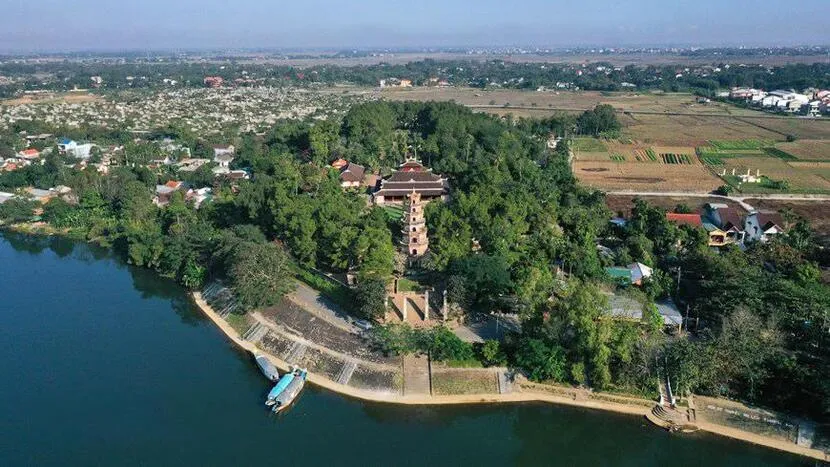
Before the pagoda was built, there was a Cham pagoda also called Thien Do (Thien Mau) on Ha Khe Hill.
According to a legend, when Lord Nguyen Hoang became governor of Thuan Hoa, he personally went to examine the land to prepare a plot to expand the territory and build the country. During a horseback ride along the banks of the Perfume River looking at the spring, he saw a small hill that jutted out over the bank of the meandering blue water. The land is shaped like a dragon looking back . People call it Ha Khe Hill.

The locals revealed that at night an old woman wearing a red shirt and blue trousers would appear on the hill and told everyone: 'There soon will be a true lord who will come and create a temple to raise spiritual energy, strengthen the dragon's vein and make the country powerful'. Therefore, this place is also called by the sacred name Thien Mu Son (means the mountain of the Heavenly Lady).
Lord Nguyen Hoang's ideal seemed to have reached the will of the people. In 1601, Lord Nguyen Hoang built a temple on the hill, overlooking the Perfume River and named it Thien Mu pagoda.
Unique architecture of the Thien Mu pagoda
Dai Hung Palace is the main hall of the pagoda with the architectural style of Trung Thiem Diep Oc (double roof, duplex house) - a popular royal roof style. In 1959, it was restored with the trusses made of concrete on the outside with a layer of faux wood paint. In the shrine, there is a statue of the smiling Maitreya Buddha. At the top is a wooden painting with four words 'Linh Thu Cao Phong' written by Lord Nguyen Phuc Chu in 1714. The Dai Hung Palace is the main hall of the Thien Mu Pagoda. The statue of the Maitreya Buddha has huge ears to listen to the suffering of sentient beings. This Buddha has a big belly to tolerate people's mistakes with a very kind smiling face.
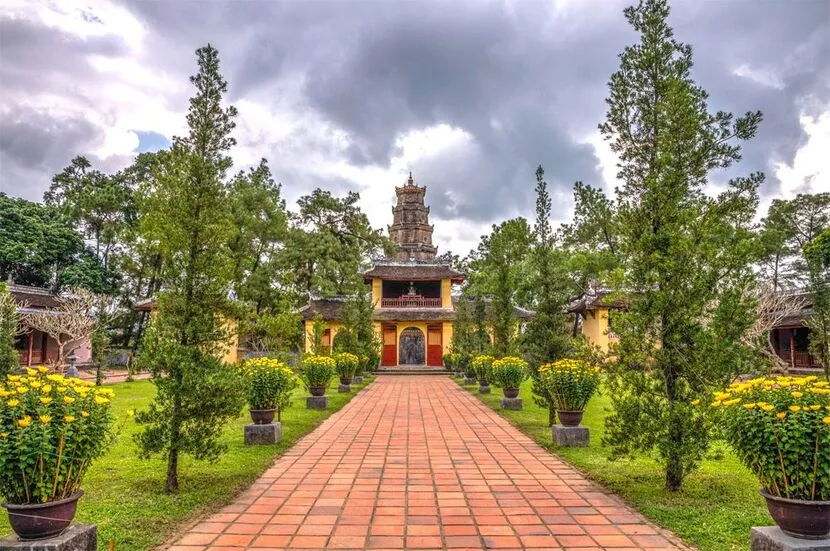
In the pagoda area, there is a flower garden that is taken care of and cultivated every day. There, there is a bonsai tree of Dao Tan who was the founder of the ancient Vietnamese music Tuong. Next stands an old car, a relic left by the late Venerable Thich Quang Duc before he set himself on fire to protest against the Ngo Dinh Diem regime's policy of suppressing Buddhism in 1963. At the end of the garden is the tomb of the late Venerable Thich Don Hau, the famous leader of the Thien Mu Pagoda, who dedicated his life to helping people.
Follow the side of the building to go around to the back of the garden, you will see a gallery with an Austin car inside associated with the tragic event of monk Thich Quang Duc who self-immolated in protest against the Ngo Dinh Diem regime's brutal policy of discrimination against Buddhism and suppression of religious freedom. Currently, the Austin A95 Westminster with registration plate DBA 599 is preserved and displayed at the Thien Mu Pagoda in Hue, the car is old, the colour of the paint fading over time.
There are very artistic and skilful carvings on the roofs of the pagodas. Apart from the beauty of the architecture and the special history, the Thien Mu Pagoda is also a place where many valuable antiques, horizontal paintings, ancient couplets, rare ancient statues, many bronze bells and all are both precious in history and art are preserved. Looking down from the courtyard of the pagoda is the Perfume River flowing gently in the middle of the vast sky. Boats quietly moor at the quay, waiting for guests to visit the Buddhist temple. The three-leaf pines of temperate countries always radiate a fresh green colour, casting their shadows to cover the cool courtyards of the pagoda. Visiting the Thien Mu pagoda, you might forget all the fatigue, the heat or the long distance. There exists only peace and relaxation in your soul.
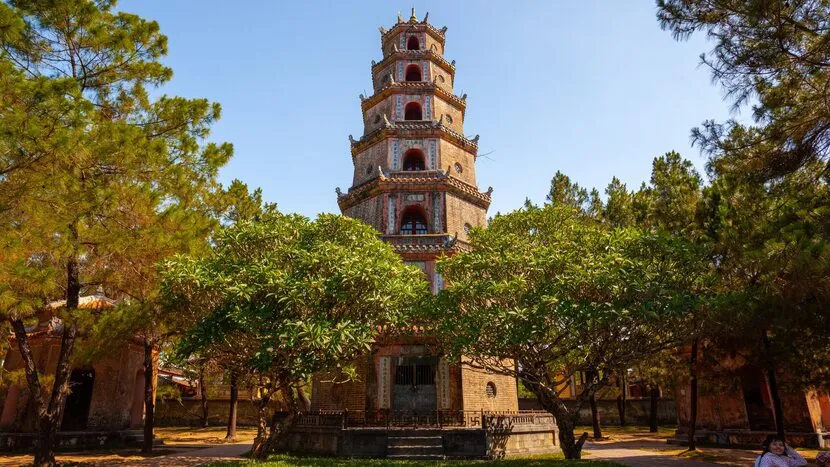
Continue your visit, you will see a tall mossy tower called Phuoc Duyen Buu Thap. Phuoc Duyen Tower is a famous landmark associated with the Thien Mu Pagoda. The 21 m high octagonal tower consists of 7 floors. The number 7 is the spiritual number in Buddhism. 7 floors of the tower are dedicated to 8 Buddhas, of which there are Buddha Shakyamuni and Avalokitesvara Bodhisattva. Inside there is a spiral staircase leading to the top floor, where there used to be a golden Buddha statue.
How to get to Thien Mu Pagoda?

Thien Mu Pagoda is about 4 km from the Hue city centre, so you can get here by motorbike, bicycle or boat.
- To reach Thien Mu Pagoda, you can rent bicycles, self-driving motorbikes or take a taxi, mototaxi, cyclo, etc.
- Another way is to reach Thien Mu Pagoda by boat. You can buy boat tickets at the Huong river harbour in Hue city centre.
Extra things to note
- If you take a boat to Thien Mu Pagoda, you can combine it with a visit to Hon Chen Palace, Minh Mang's Tomb or Huyen Khong Son Thuong Pagoda.
- Bicycle tour to Thien Mu Pagoda should be taken in the early morning or late afternoon to avoid the heat.
- In addition, like visiting all other temples and pagodas, please don’t wear trousers, skirts or dresses shorter than your knee. Also please do not make noise or say bad words.
- Currently there is no Thien Mu entrance fee. It is open for public.
To see more about Hue:
>> Full day private Hue city tour
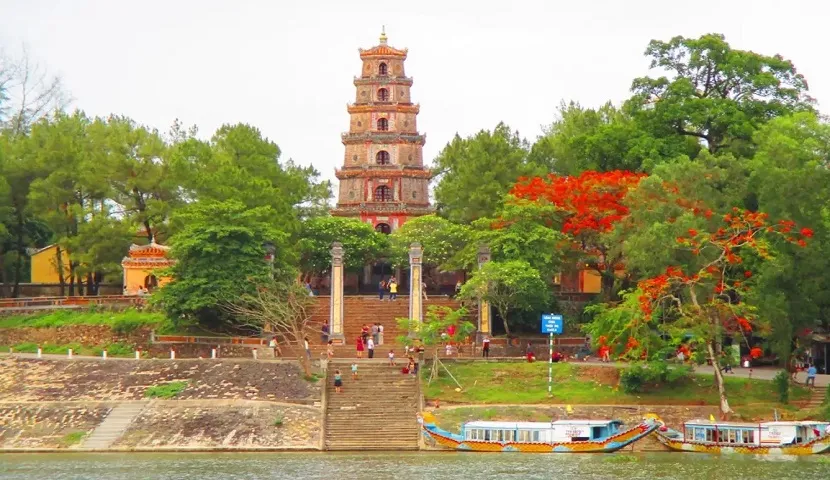








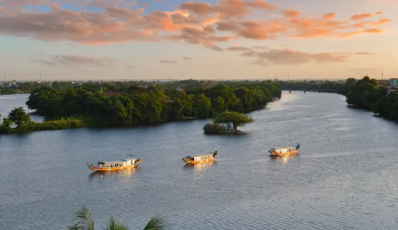
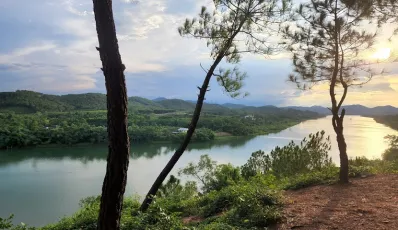
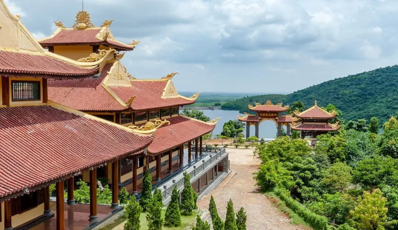
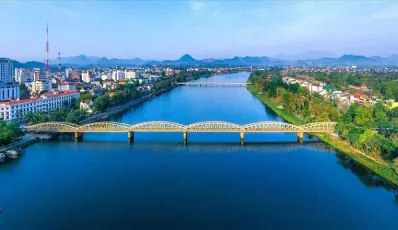
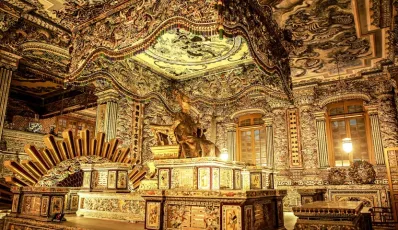

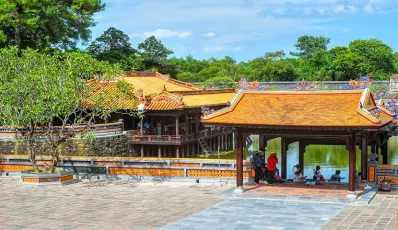





 TRAVELERS' CHOICE 2025
TRAVELERS' CHOICE 2025 


